Philips 3200 LatteGo Review 2023: The Most Intuitive Design?
Summary
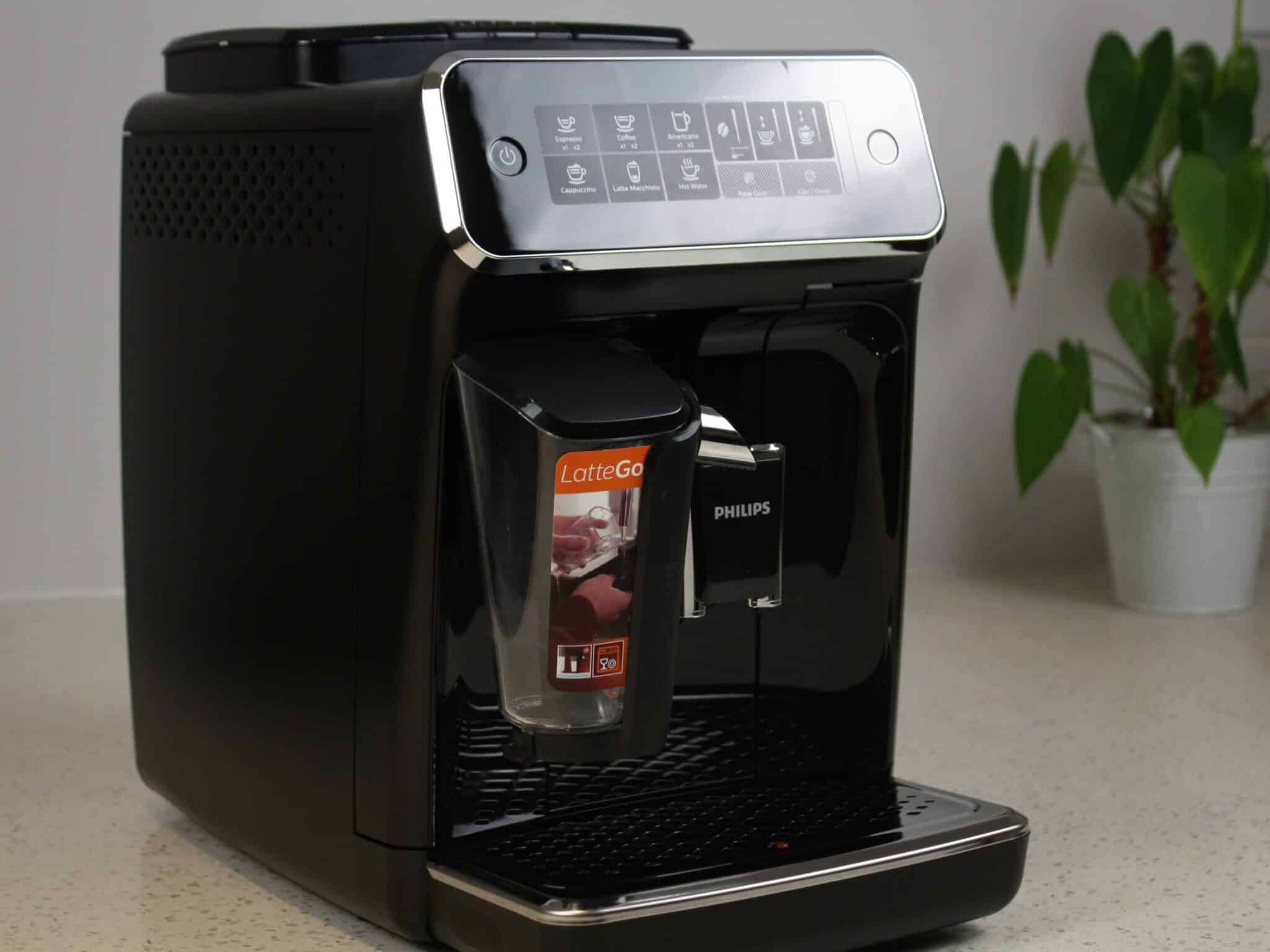
Pros
Cons
Philips 3200 LatteGo Summary
The Philips 3200 LatteGo is an excellent value super automatic espresso machine. It does not have as many features as other machines, but it’s one of the easiest machines to use, clean and maintain. We were satisfied with the espresso quality and the LatteGo milk system dispenses sweet and creamy milk. However, the milk texture is a bit thick, ideal for cappuccinos but not for latte art. Some features are missing and the machine is a bit loud, but given the price tag, this Philips machine provides excellent value.
Are you looking for a cost-effective, intuitive automatic espresso machine that makes great espresso drinks, requires minimal cleaning, and does not cost an arm and a leg?
This seems like an impossible number of design constraints to incorporate into a home espresso machine…yet, it looks like Philips attempted to do this with this LatteGo machine.
But did they succeed?
Read this detailed Philips 3200 LatteGo review to find out!
Overview
At a Glance
- A minimalistic and compact espresso machine that is only 9.6 inches (24.6 cm) wide.
- Mostly made of plastic (except the drip tray), the build quality is better than expected given the price point of this machine.
- This is one of the easiest-to-use and most intuitive automatic espresso machines on the market. This is thanks to a very well-designed touch control panel with clearly labeled icons telling you exactly what each button does.
- This machine is an excellent value purchase due to its price relative to the number of features and the coffee drink quality.
- This Philips espresso maker comes with 5 pre-programmed coffee drinks which include espresso, coffee, americano, cappuccino, and latte drinks.
- Easily make double-shot black coffee drinks by pressing the drink buttons twice.
- There are 3 levels of customization for the coffee strength, coffee and milk volumes, and temperature.
- The ceramic flat burr grinder has 12 levels of adjustment. A ceramic grinder remains sharper for longer than a stainless steel one.
- The LatteGo milk frother dispenses sweet and creamy milk; however, there is no milk customization.
- The LatteGo milk texture is more suitable for cappuccinos than lattes. The resulting foam is a bit thick.
- The Philips 3200 LatteGo is very easy to clean. The LatteGo milk system only consists of 3 parts which can be washed by hand or in the dishwasher.
- The brew unit is removable for a thorough cleaning.
- This machine comes with the AquaClean water filter which lasts for 625 coffee preparations and minimizes the need for descaling to only every 5,000 cups.
- There is a pre-ground coffee chute; however, steam exhausts from this same opening. This could become an issue if you regularly use pre-ground coffee, as any leftover coffee grounds inside will collect moisture.
- The Philips 3200 LatteGo is quite loud.
- Some common features such as user profiles, milk temperature and customization, connectivity, a cup warmer, and more programmability are missing. However, we are okay with this given the cost of this machine.
Some Useful Specs
- Model: Philips 3200 LatteGo (EP3241)
- Type: super-automatic espresso machine
- Dimensions (W x H x D): 9.6 x 14.6 x 17.0 inches (24.6 x 37.2 x 43.3 cm)
- Weight: 17.6 lbs (8 kg)
- Pump pressure: 15 bar
- Water tank capacity: 60.9 oz (1.8 L)
- Bean hopper capacity: 9.7 oz (275 g)
- Adjustable spout height: 3.4 to 5.7 in (8.5 to 14.5 cm)
- Grinder type: Ceramic flat burr grinder with 12 adjustment levels
- User Profiles: None
- Number of pre-programmed drinks: 5 (espresso, coffee, americano, cappuccino, and latte)
- Hot water dispenser: Yes
- Display Type: None - touch control panel with icons and lights
- Brewing System: Internal removable brew unit (part #421944092331)
- Milk Frothing System: LatteGo
- Ground coffee bypass: Yes
- Warranty: 2-year manufacturer warranty
- Power Requirements:1,500 W
Design and Build Quality
The Philips 3200 LatteGo is a super-automatic espresso machine that offers a compact, minimalistic design. It is entirely made of plastic, except for the drip tray which is made of stainless steel.
The large amount of plastic should not deter you from considering this latte machine. Even espresso machines like the JURA E8, which cost 3 times as much, are made of plastic.
The build quality is surprisingly high for this price point. The water tank and the paneling are thick, feel sturdy and fit well. Ironically, the drip tray, which is the only non-plastic piece of this machine, fits a bit loosely but that certainly isn’t a deal breaker.
This Philips machine is relatively compact, measuring 9.6 x 14.6 x 17 in (246 x 372 x 433 mm) in width, height, and depth. If you are placing your machine under your kitchen cabinets, make sure you account for additional clearance because you will need extra space to add the coffee beans.
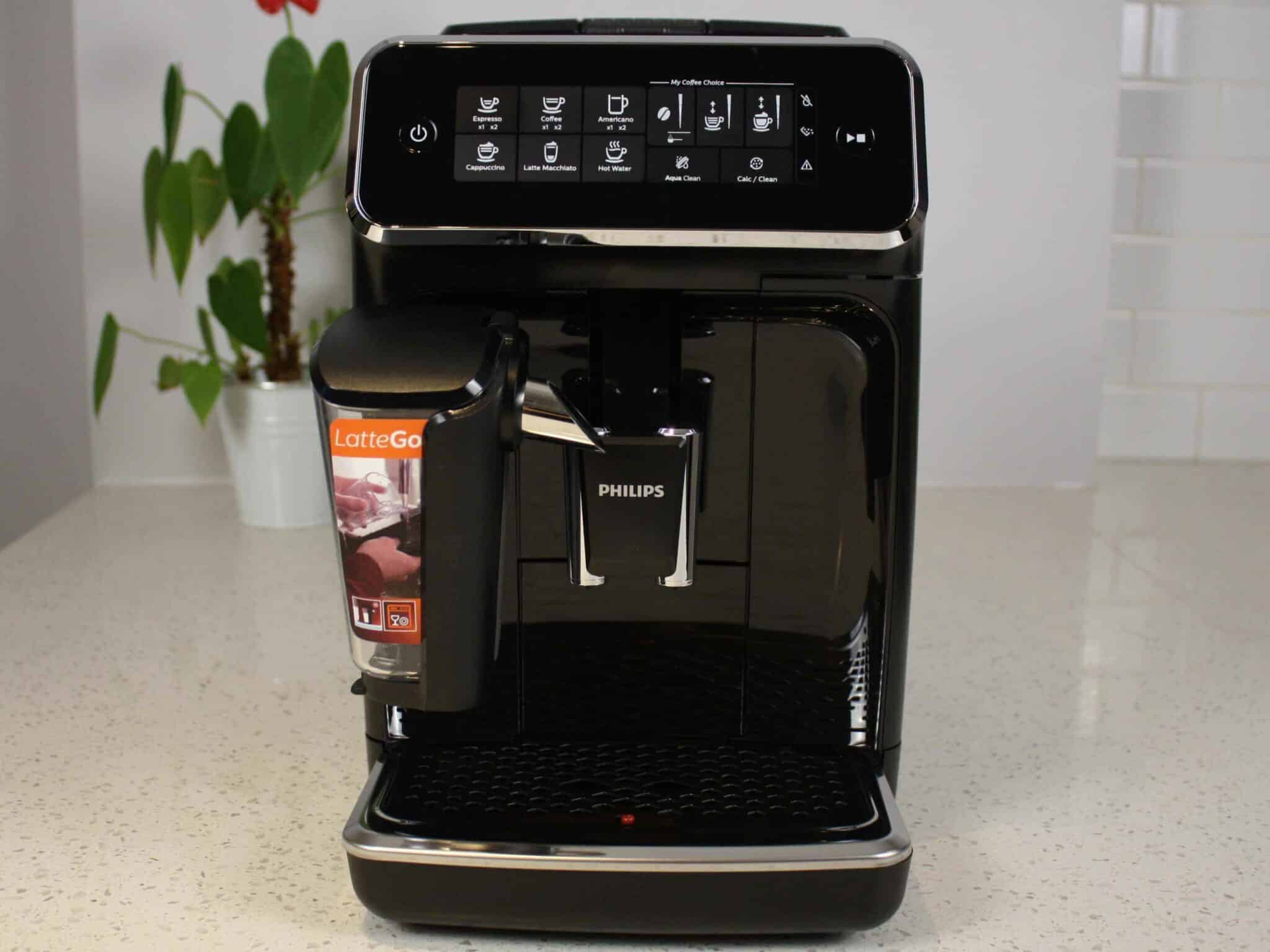
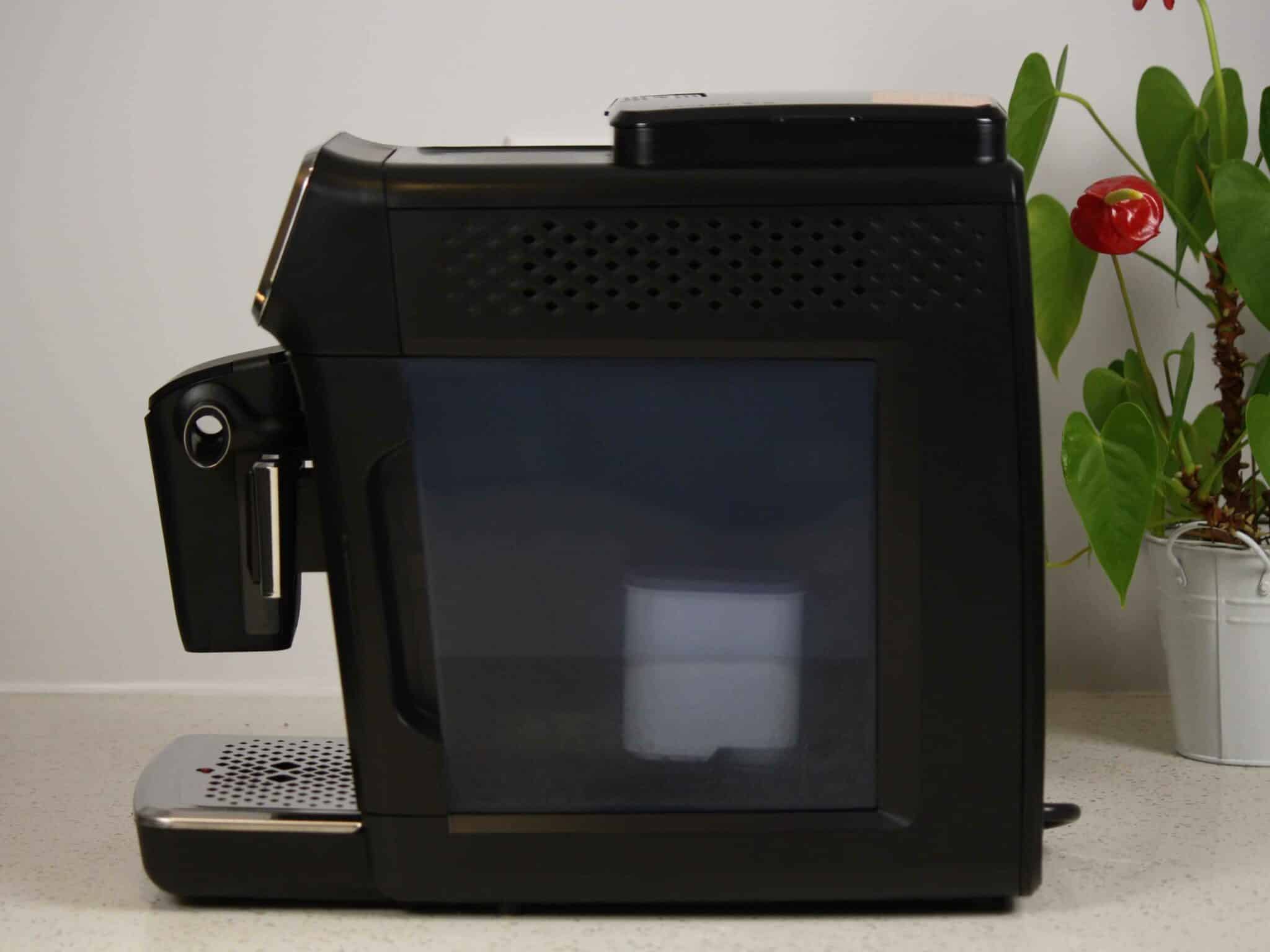

This machine comes with an adjustable coffee spout, ranging from 3.4 to 5.7 in (8.5 to 14.5 cm). However, the LatteGo milk spout sits a bit too high and cannot be adjusted.
One of the most prominent features of this machine is its control panel. It's simple, elegant, and most importantly, highly intuitive.
It is so intuitive that just by looking at it you get an idea of the drink menu and features of this machine (more on that below).
The control panel consists of 11 touch sensors and 5 status indicators. Six of the 11 touch-sensor buttons are dedicated to the drink menu, which consists of espresso, coffee, americano, cappuccino, latte macchiato, and hot water drinks. Three buttons are used to customize the coffee strength, volume, and milk volume. Finally, the remaining two buttons are the power and the Start/Stop buttons.
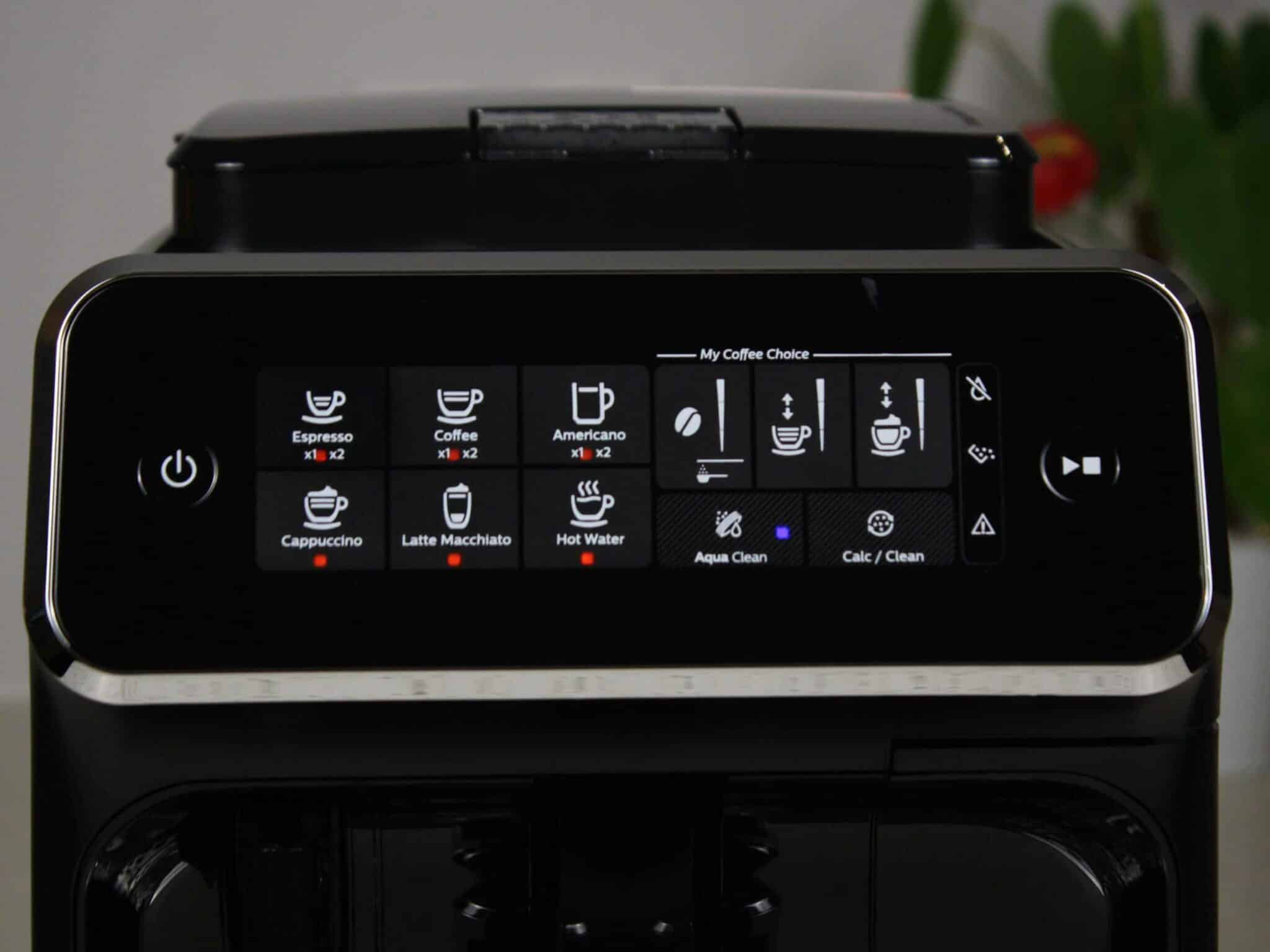
Each of the touch sensors is labeled with well-designed icons so that you know exactly what each button does.
The coffee bean hopper is located on the top and has a capacity of 9.7 oz (275 g) which is plenty. Near it, there is the ground coffee bypass chute and the ceramic grinder adjustment which has 12 levels.
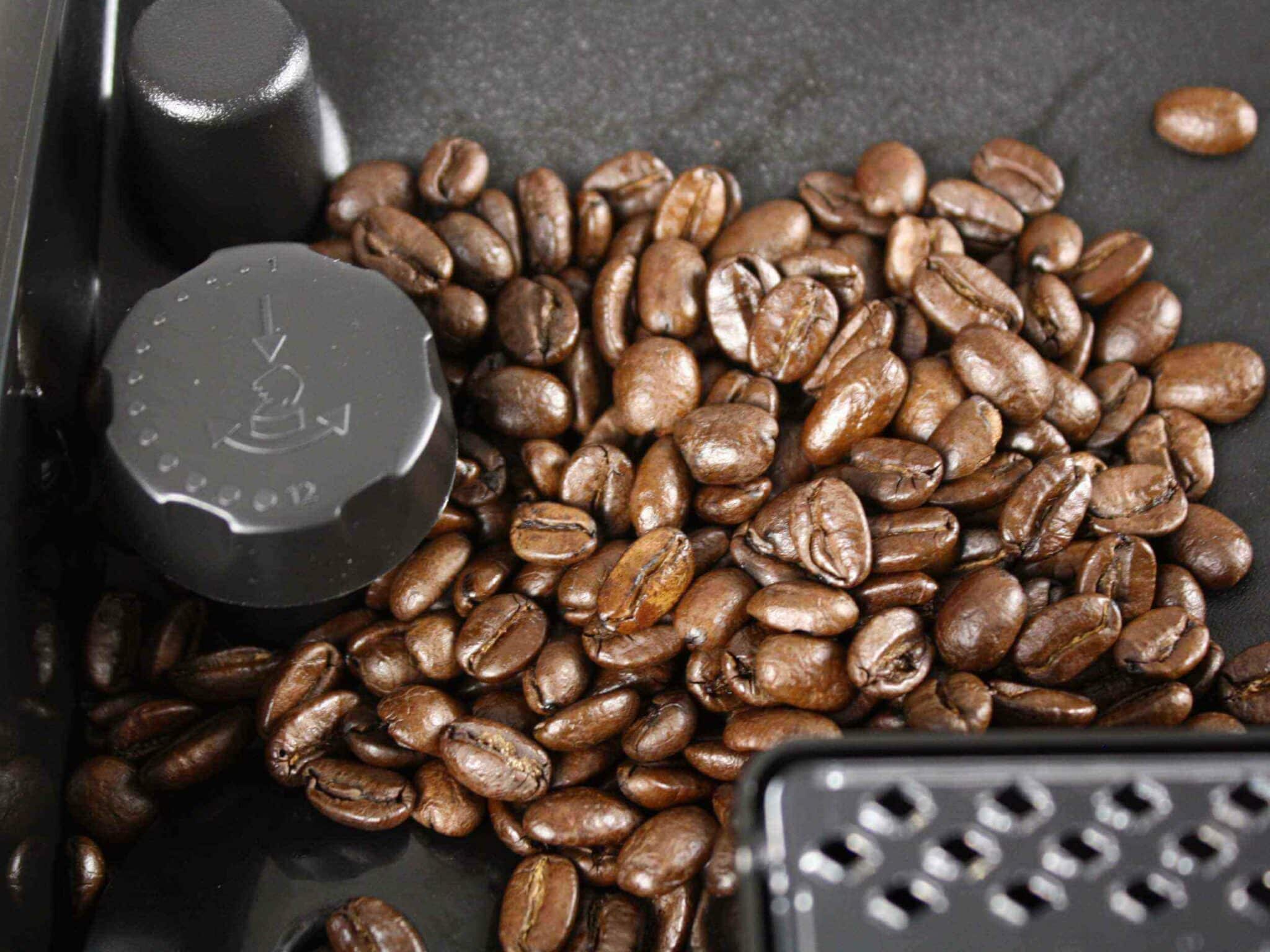
Something I noticed is that the ground coffee chute also functions as an exhaust. I saw steam coming out of it, which seems a bit questionable. The chute is impossible to clean, and if you have used pre-ground coffee there will certainly be coffee grounds stuck in there that will be exposed to steam constantly and will collect moisture.
I see this as a minor issue, since the coffee police may not be too happy if they hear you are not using fresh whole coffee beans with this baby!
The removable water tank is considered large at 61 oz (1.8 L) of capacity. It can easily be pulled from the front of the machine to refill or rinse.
Finally, the LatteGo milk frothing system is very well designed. It only consists of 3 pieces: a clear milk container, a black sheave, and a lid. Installing it into the machine is at first a bit tricky, but once you do it a few times it becomes second nature.
If the clear receptacle contains milk, do not detach it from the black clip. I did not read the instructions at first (because this is such an intuitive machine) and detached the clear receptacle from the black clip.
The result was a huge mess with milk all over the countertop!
In terms of cons, the Philips 3200 LatteGo is quite loud. If you are sensitive to loud noises or plan to use this machine in the wee hours of the morning, you may wake up your household.
In short, the Philips 3200 LatteGo offers a minimalistic and highly intuitive design. It is compact and made of plastic - but a good quality one. The water tank and bean hopper are large and can be easily refilled, while the LatteGo system is easy to install or remove from the machine. This machine is quite loud and the use of the pre-ground coffee chute as a steam exhaust is a bit questionable.
Features and Ease of Use
For its price point, the Philips 3200 LatteGo automatic espresso machine comes with a fair bit of features, while being one of the easiest home espresso machines to use. I might go as far as saying that it is the most intuitive coffee maker we have tested so far.
It comes with 5 pre-programmed coffee drinks which are espresso, coffee, americano, cappuccino, and latte macchiato. There is also a hot water drink button.
If you want an espresso, press the button with the espresso icon and then press the Start/Stop button. Want a double-shot? Press the espresso button twice and a second light will light up, indicating that your machine is ready to dispense a double espresso.
Unfortunately, the double-shot option is not available for cappuccino or latte macchiato drinks. So to get a double shot cappuccino or latte macchiato, then you have to first pull a single espresso shot, then make a cappuccino or latte macchiato.
There are 3 levels of customization for the coffee strength, volume, and milk volume. Customizing your drink is highly intuitive. After selecting your drink, the buttons corresponding to the above settings will light up. The currently selected settings are graphically shown using three lights; one light means low whereas three lights mean high. This can be seen in the picture below.
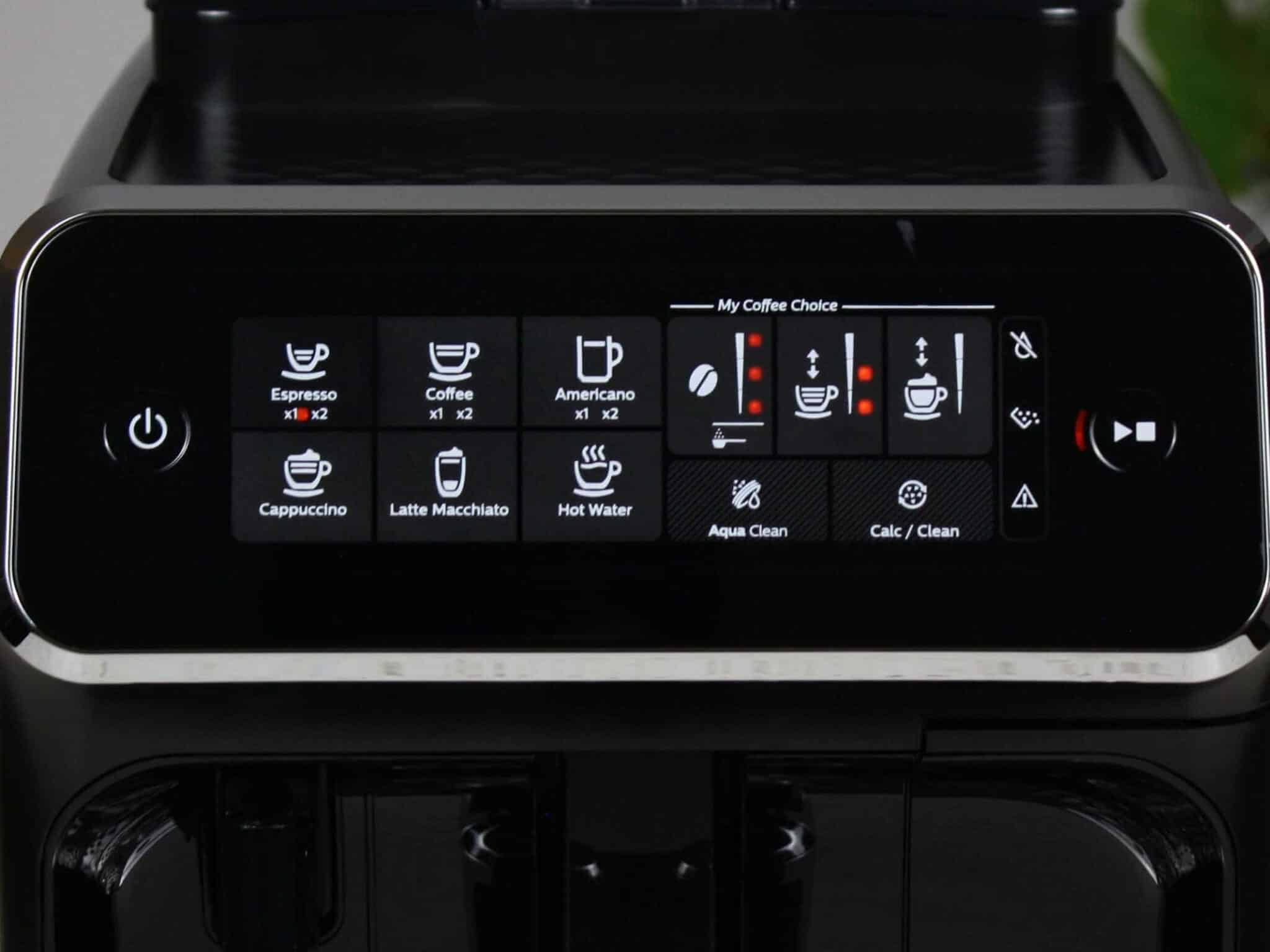
There are also 3 levels of temperature adjustment but this feature is a bit hidden. To change the brewing temperature, you need to turn off your espresso machine first, then press and hold the coffee quantity icon until its lights turn on.
It is noteworthy to note that this 3200 LatteGo remembers the previously used settings so that you don’t have to set things again.
This espresso machine comes with a flat burr ceramic grinder with 12 levels of adjustment. It is quite rare to see an espresso machine at this price point with a ceramic burr grinder. The advantage of ceramic versus stainless steel grinders is that the ceramic ones do not lose their sharpness and do not get as hot, something which could potentially impact your coffee if you prepare many drinks in a row.
There is some programmability. You can configure the stand-by time to 15, 30, 60, or 180 minutes. This can be done when your machine is off while pressing and holding the Calc/Clean icons.
Some common features that are lacking include the following:
- User profiles
- A cup warmer
- A dedicated milk drink (e.g. if you just want frothed milk)
- On/off based on a specific time
- Wireless connectivity
- Customizable milk textures and temperature
Despite lacking the above features, we do not penalize this machine because of its price point. Even home espresso machines costing 2 or 3 times more than this Philips lack some of these features.
In short, we think Philips has found a very good trade-off between features, ease of use, and cost. It allows you to customize the strength, volume, and temperature of the 5 pre-programmed drinks it comes with. Some common features are missing, but this is okay given the cost of this machine.
Coffee Drink Quality
Let’s get something out of the way - your espresso shot will not be as good as your local café. Nothing really beats espresso extracted using a portafilter. Not even high-end machines like Miele’s CM6350 or the JURA E8 can achieve coffeeshop quality espresso (even though they like to claim they do).
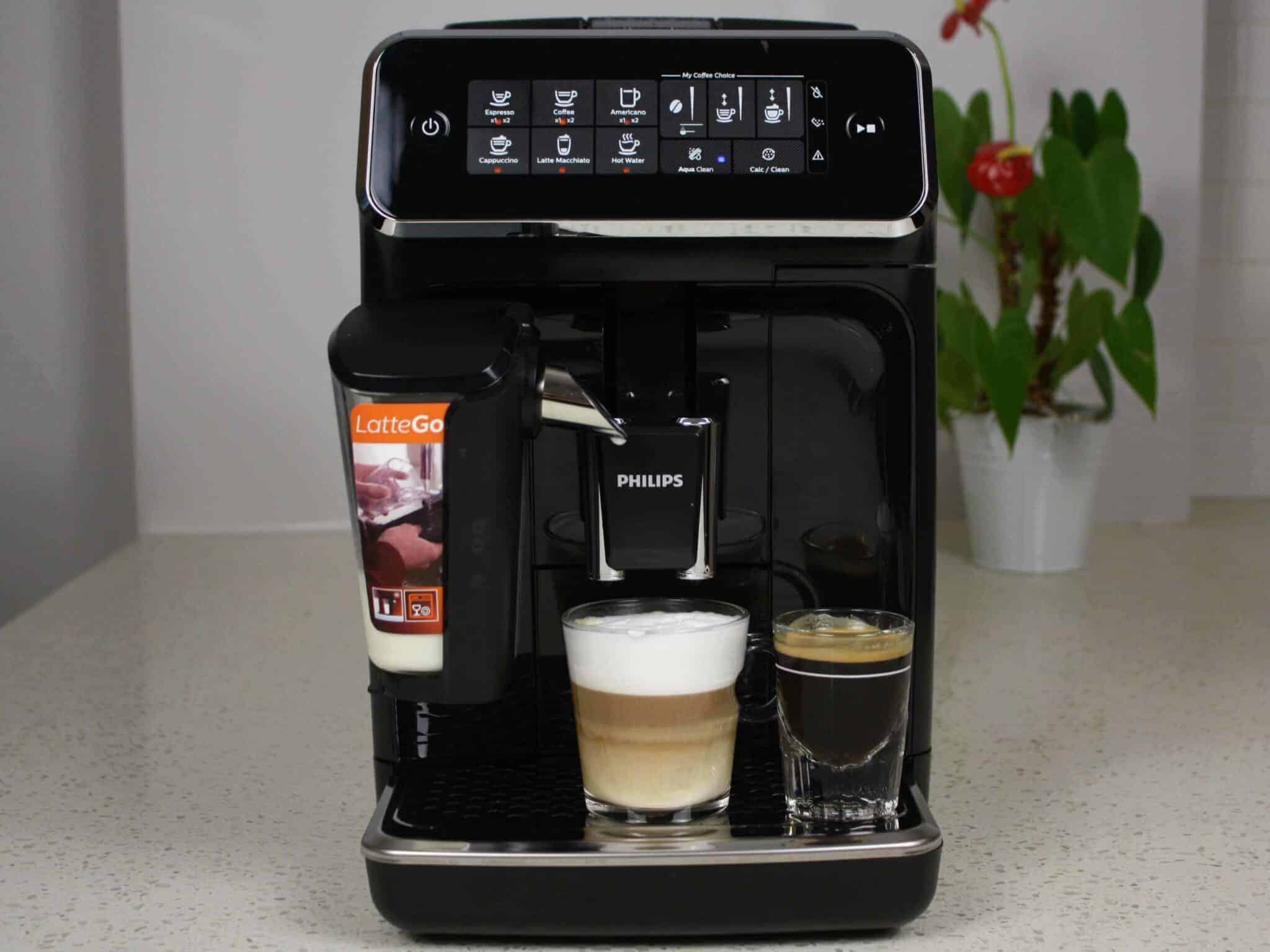
With that being said, the Philips 3200 LatteGo makes a mean espresso cup with good crema for a home fully automatic espresso machine, especially one at this price point.
I was taken aback by how quickly the espresso was extracted and I did have to change the grind settings and other espresso customization options before I was happy with my espresso.
Using the default settings, the espresso shot was a bit watery. So, I cranked up the temperature to the max, changed the grind settings to a finer level, maxed out the coffee quantity, and selected the lowest coffee volume setting.
The end result was an espresso shot I was satisfied with.
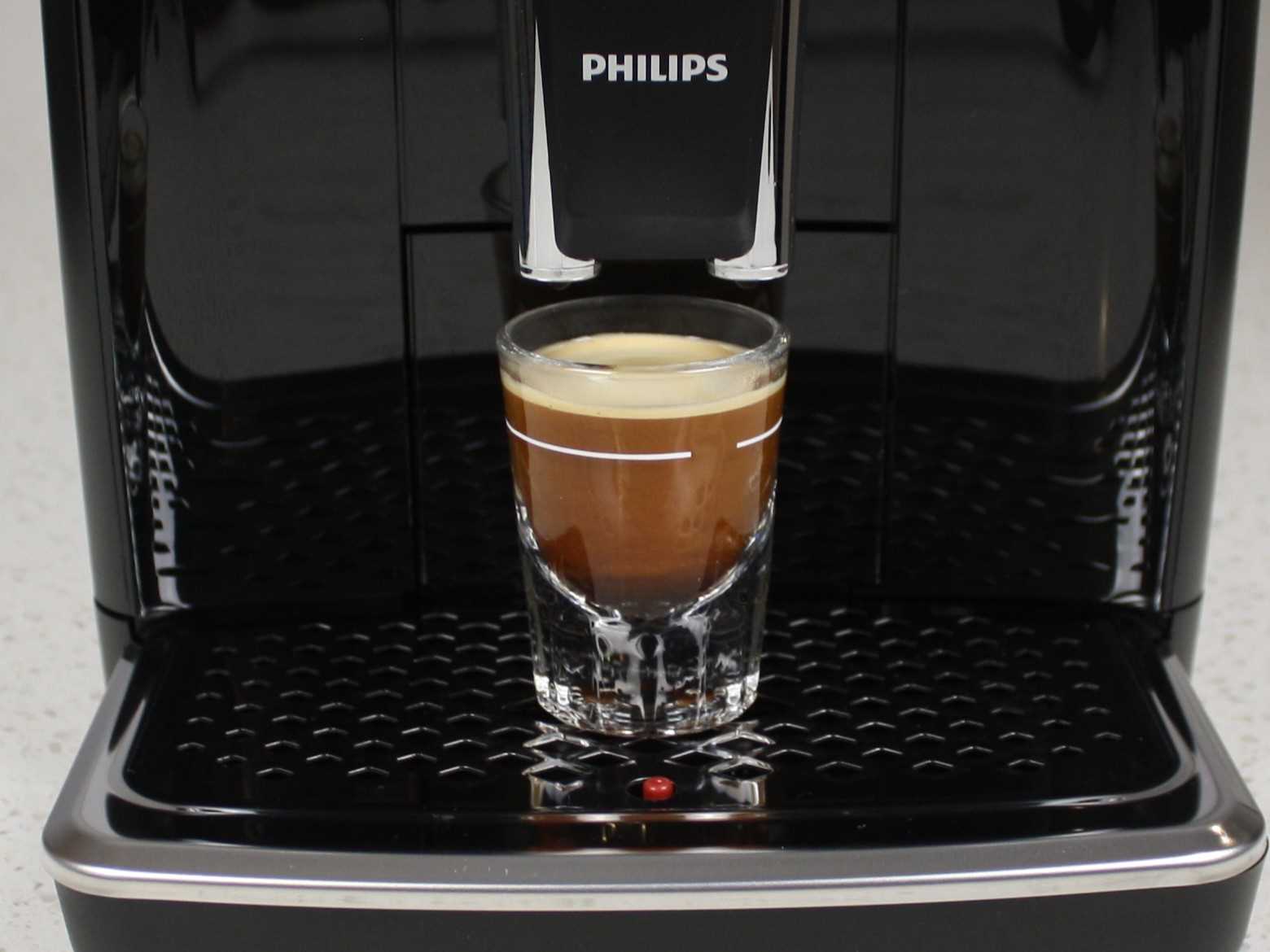
By the way, changing the default settings of your machine is entirely normal to do if you are to utilize your machine’s full potential, especially if you are changing coffee bean types or just purchased it.
This espresso machine pre-infuses the coffee grounds and comes with Philip’s Aroma Extract System, which is an intelligent brewing system that balances temperature and aroma extraction by maintaining the water temperature between 194 to 208 degrees Fahrenheit (90 to 98 degrees Celsius).
I was not able to find a more detailed description of how this technology works, but it seems to me what Philips is trying to say is this machine will try to avoid temperature fluctuations by keeping the temperature within the above range.
Something you may notice is that, similar to other automatic espresso machines, the Philips 3200 first adds milk to your cup and then espresso, when making drinks such as cappuccinos. In reality, the correct order is espresso first and then the milk.
What about the LatteGo system? What is all the hype about?
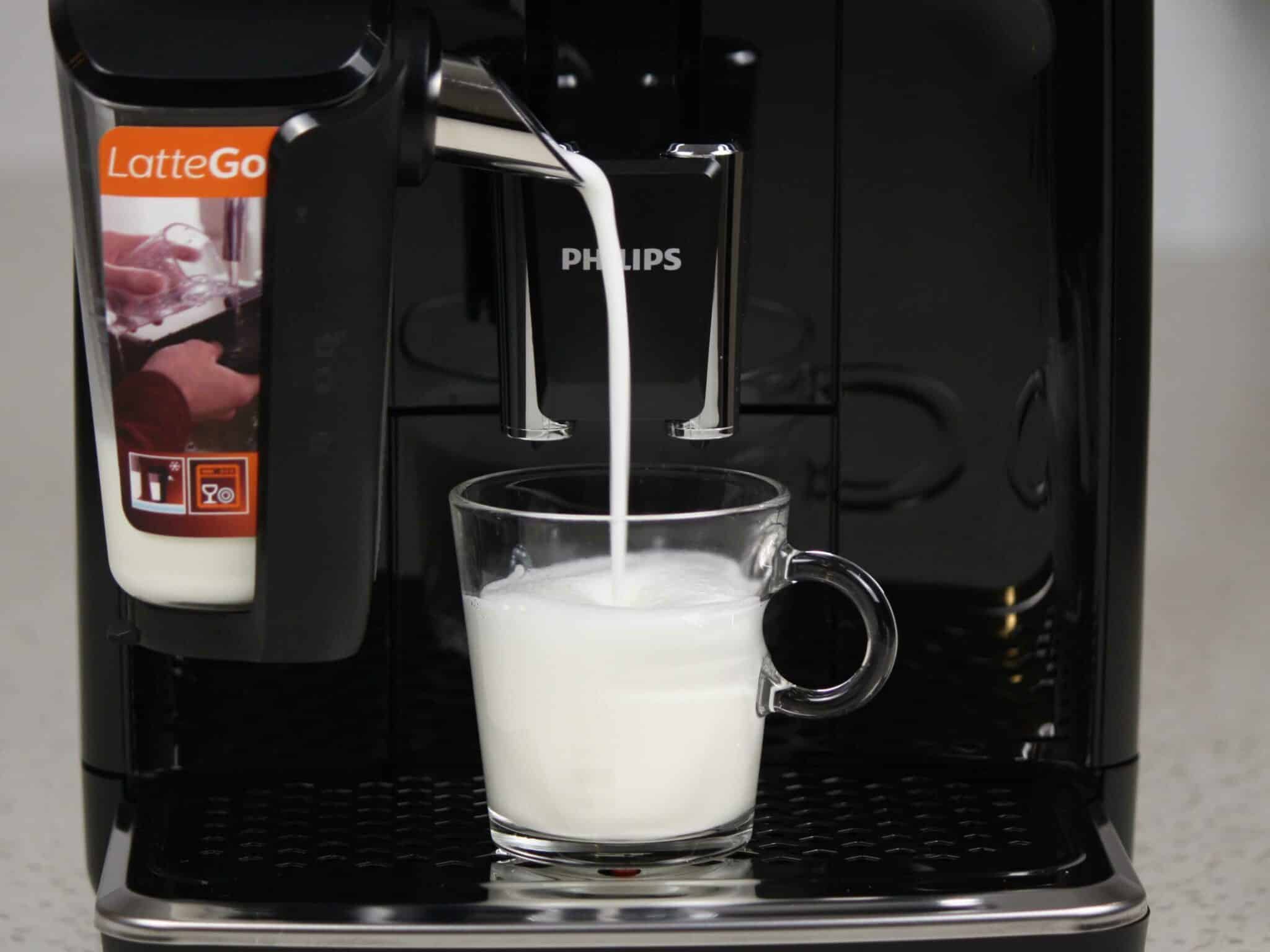
Let’s start with the cons. It dispenses milk foam that is quite thick and more appropriate for cappuccinos than lattes. And no, you cannot select the milk foam texture. So if you are looking for an automatic espresso machine to practice your latte art skills, then this Philips is not for you. We recommend an espresso machine with a steam wand, such as one of the Breville Barista models or even the Bambino models.
Another con is the spout of the LatteGo system is a bit too high relative to your cup, especially if you are preparing smaller drinks like a cappuccino. The milk has to travel a long way down before reaching your cup, and if you’re not careful, you could miscalculate your cup placement and end up with half the milk on your counter.
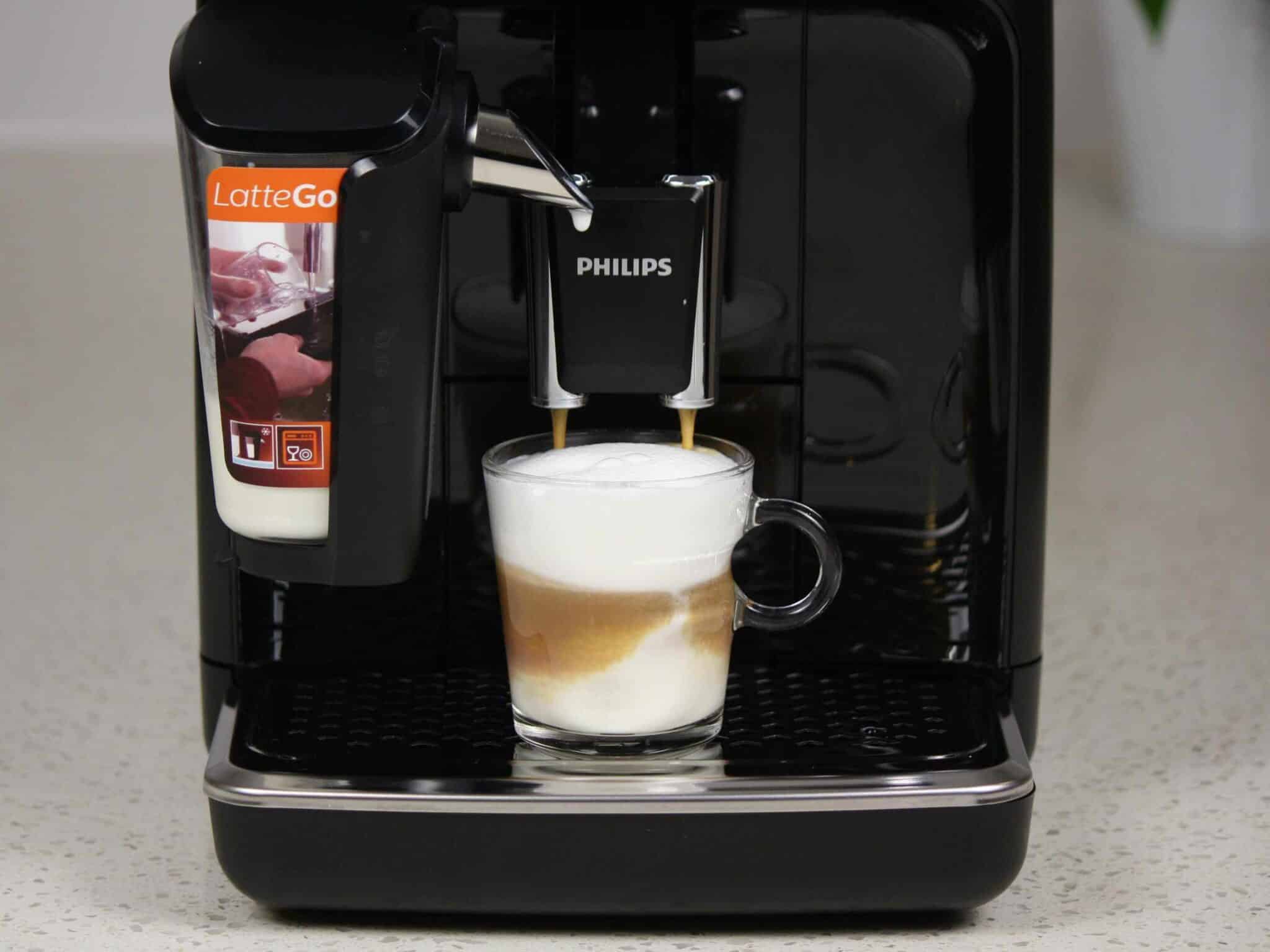
In terms of pros, the LatteGo milk system is extremely well-designed due to its simplicity. It just consists of 3 pieces that can be rinsed or thrown into the dishwasher. This simple system improves reliability, reduces cost, and helps keep things clean.
In addition, we found the milk to be sweet, which means it was heated to the correct temperature range and not scalded.
In short, the Philips 3200 can prepare delicious espresso-based drinks by simply pressing a few buttons. The LatteGo system dispenses delicious sweet and creamy milk, with a texture that is more appropriate for cappuccinos than lattes.
Ease of Cleaning and Maintenance
Many automatic espresso machine brands claim how easy it is to use their machines. Yet, when it comes to cleaning, it’s a whole other story.

Thankfully, the Philips 3200 LatteGo not only is easy and intuitive to use, but this machine shines in the cleaning and maintenance department (and it’s also shiny when cleaned properly).
The biggest culprit when it comes to cleaning super automatic espresso machines is the milk system. Some machines require you to disassemble the milk system into many small pieces, which sometimes are not dishwasher safe. This can take a good 15 to 20 minutes every day, which is quite inconvenient.
With the LatteGo system, you only have 3 pieces to worry about and they are all dishwasher safe. There aren’t any pipes where milk could hide, so the rinsing process is also supremely easy.
Other components which require regular cleaning are dishwasher safe, including all components of the drip tray minus the front panel of the spent coffee grounds container.
There are warning icons that light up to tell you what your machine needs, such as the “water tank empty” or the “empty coffee grounds” lights, or to tell you when your machine needs descaling.
In addition, this Philips espresso maker is compatible with AquaClean water filters. This should minimize the number of times you need to descale your machine - Philips claims you can prepare 5,000 coffee cups before any descaling is required.
There are automatic rinsing cycles when you turn on and off your machine, which helps keep things clean, but they are not enough on their own to keep the brew unit clean, as can be seen in the picture below.
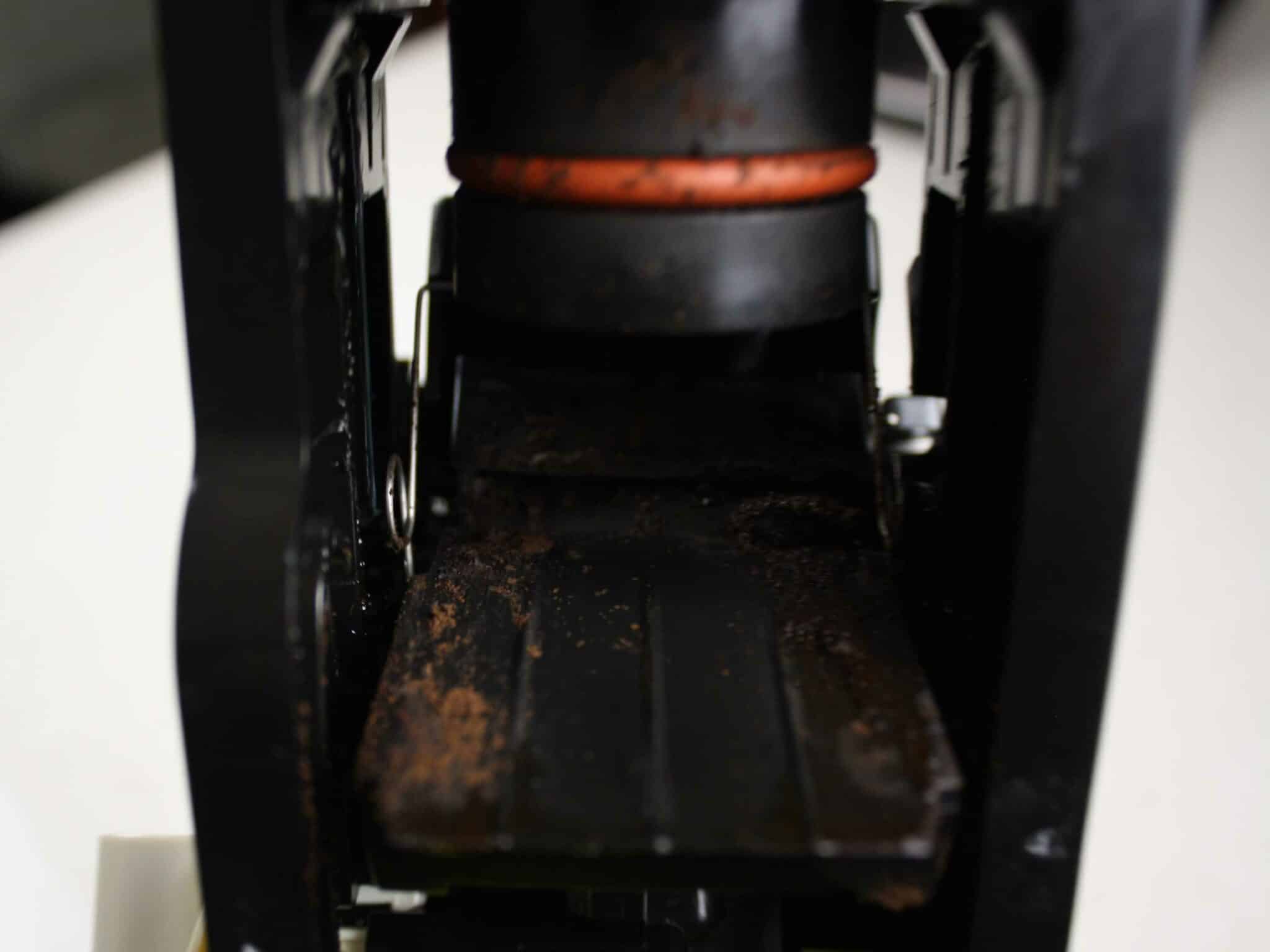
It’s a good thing then that the brew unit can be removed for regular rinsing (at least per week as per Philips instructions). A deeper cleaning program should be run every 2 months involving coffee oil remover tablets.
The only con is that the grinder cannot be accessed for a thorough cleaning.
In short, the Philips 3200 LatteGo gets very high marks in the cleaning department. It’s one of the easiest to clean bean-to-cup espresso machines available.
Value for Money
The Philips 3200 LatteGo is one of the best value espresso machines in the market, period.
And yes, there are other budget machines that are hundreds of dollars cheaper, but “budget” is not to be confused with “good value”. You could have a budget machine that costs $250 but is a piece of crap, resulting in low value for money.
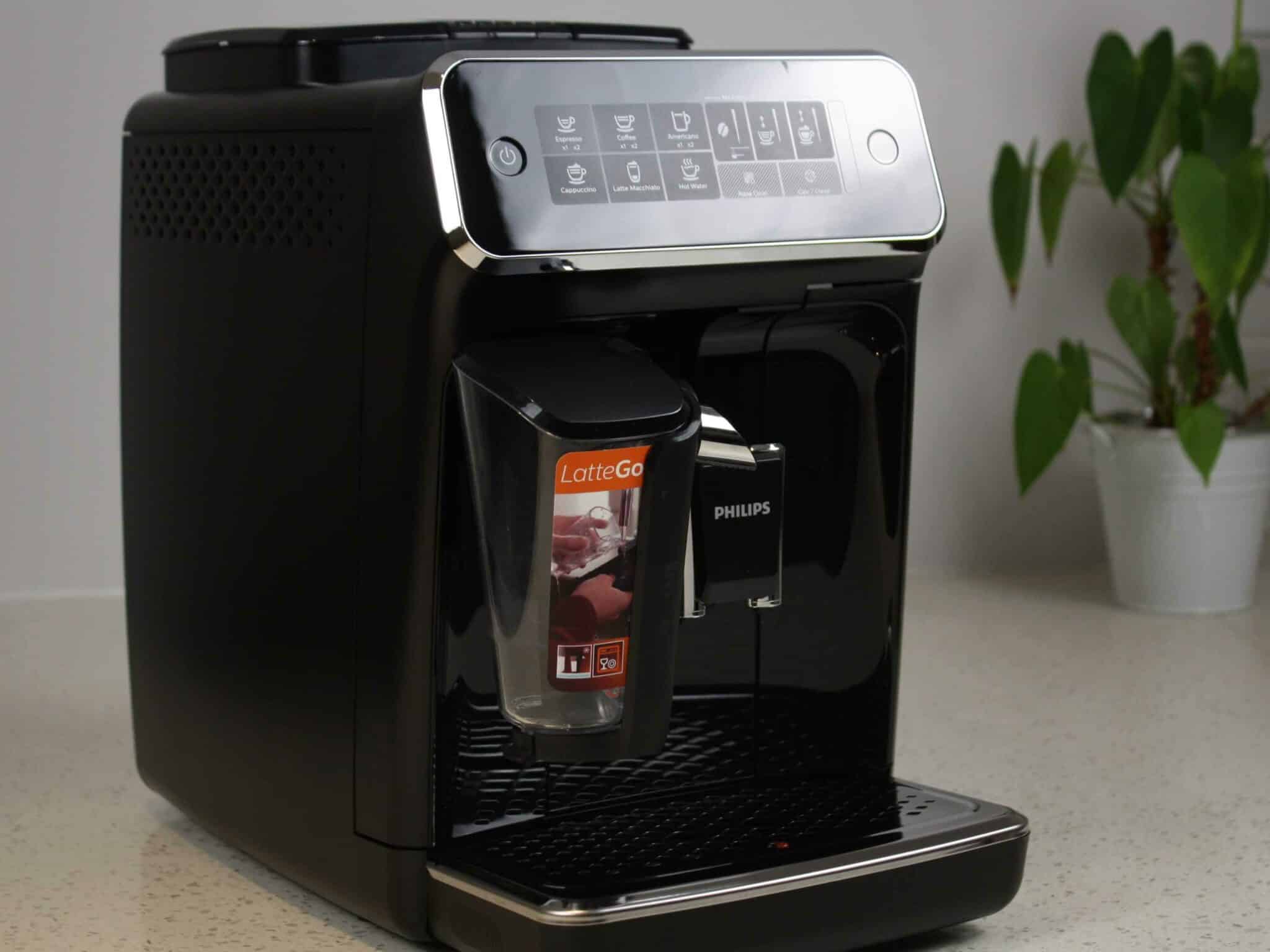
Philips, with the 3200 LatteGO, nailed the balance between cost, quality, and features.
Yes, this machine is loud, it does not have a fancy color LCD screen, and the LatteGO system dispenses a single milk texture. But those features could easily end up costing hundreds of dollars more.
For instance, take a look at the DeLonghi Dinamica LatteCrema which costs about $600 more and it’s still considered a good value machine.
Further, as an engineer, I can tell you the price is low not because Philips decided to cheap out on quality, but because they thoughtfully designed this machine to be as simple as possible. I bet manufacturing the LatteGo system costs much less than manufacturing other milk systems that consist of many pieces and pipes.
Plus, a simpler machine usually results in higher reliability as there are fewer parts that can break down.
This machine comes with a 2-year manufacturer warranty which is considered above average.
In short, the Philips 3200 LatteGo offers excellent value for your money. Few other espresso machines balance quality, features, and cost as well as this one.
Verdict
Summary

Pros
Cons
Philips 3200 LatteGo Summary
The Philips 3200 LatteGo is an excellent value super automatic espresso machine. It does not have as many features as other machines, but it’s one of the easiest machines to use, clean, and maintain. We were satisfied with the espresso quality and the LatteGo milk system dispenses sweet and creamy milk. However, the milk texture is a bit thick, ideal for cappuccinos but not for latte art. Some features are missing and the machine is a bit loud, but given the price tag, this Philips machine provides excellent value.
Who is the Philips 3200 LatteGo For?
The Philips 3200 LatteGo is a great entry-level home super automatic espresso machine. It is ideal for those who want a reliable, no-fuss espresso machine that will not break the bank.
Given this is a bean-to-cup machine, this Philips is also great for those who do not want to be involved in the coffee preparation process and just want a quick cup of coffee in the morning.
If you live a busy life, the 3200 LatteGo will be your friend. It requires minimal cleaning and when you do need to clean it, the cleaning process takes only a few minutes (even cleaning the LatteGo milk system).
Finally, this espresso maker is also great for small spaces, it is relatively compact compared to other automatic espresso machines. Another similar machine worth considering is the Gaggia Brera which is even more minimalistic but costs less.
Who Should Avoid the Philips 3200 LatteGo?
The Philips 3200 LatteGo is not for those who want a luxurious experience or want to be involved in the coffee preparation process. Although 3 levels of customization for the coffee strength, volume, temperature, and milk quantity are appropriate for most coffee drinkers, this is not enough for the more advanced user.
If you are a coffee fiend who wants more customization and features but does not want to spend money on unnecessary features such as fancy color touch screens, we recommend the De’Longhi Dinamica or the De’Longhi Magnifica. You should also check our De’Longhi espresso machines recommendations for some inspiration!
If you care about the aesthetics or want a luxurious appliance with all the bells and whistles, we recommend you get the JURA E8 or Miele CM 6360, or even the Jura ENA 8 if you are tight on space.
If you want a more hands-on experience, then perhaps a semi-automatic espresso machine is perfect for you. Check our Breville’s semi-automatic espresso machines picks for more ideas!
Finally, if budget is not an issue, and you want to have café quality coffee drinks at home, we recommend the Breville Oracle Touch. It uses a commercial grade portafilter while keeping the coffee preparation automated (or manual if you want to).
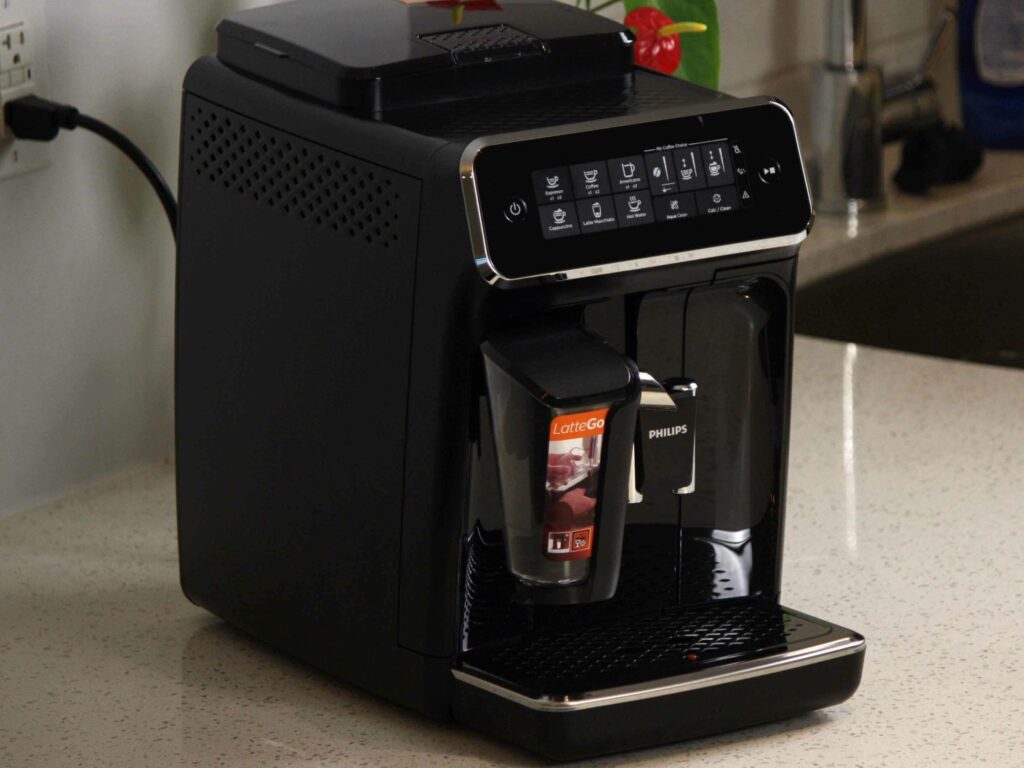
Frequently Asked Questions
Are Philips automatic coffee machines any good?
Yes, Philips automatic machines are reliable and make good coffee.
How does the LatteGo system work?
Milk is pulled via a duct built into the milk jug to a cylindrical chamber where it is mixed with hot high pressure air.
Can I use regular coffee grounds with the Philips 3200 LatteGo?
Yes, you can, there is a ground coffee bypass chute. However, we highly recommend you buy whole coffee beans!
What is the Warranty with the Philips 3200 LatteGo?
Philips offers a 2-year manufacturer warranty for the Philips 3200 LatteGo.
Is the Philips 3200 LatteGo easy to clean and maintain?
Yes, the Philips 3200 LatteGo is very easy to clean and maintain. This is one of the highlights of this machine.
